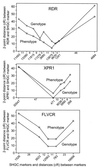Precise gene localization by phenotypic assay of radiation hybrid cells
- PMID: 10852967
- PMCID: PMC16555
- DOI: 10.1073/pnas.130200097
Precise gene localization by phenotypic assay of radiation hybrid cells
Abstract
A high resolution map of the human genome previously has been constructed by using the G3 panel of human/hamster radiation hybrid cell lines and >15,000 unique human genetic markers. By determining whether human DNA sequences are present or absent in each of the hybrids, localization of single genes may routinely be achieved at approximately 250-kb resolution. In this paper we have tested whether similarly precise localization might be achieved by phenotypic screening of the hybrids to facilitate positional cloning of unknown genes. We assayed the susceptibility of each of the hybrid cell lines to transduction by retroviral vectors bearing different retroviral envelope proteins that recognize receptors present on human but not on hamster cells. The results for each of the retroviral vectors were informative and allowed precise localization of the receptor genes for the RD114 cat endogenous retrovirus, xenotropic murine leukemia virus, and type C feline leukemia virus. After cloning of the receptors for these retroviruses, we found that standard genotypic mapping by PCR gave results that were nearly identical to those from phenotypic mapping. These experiments show that precise gene localization by phenotypic assay of radiation hybrids is practical and was not appreciably impacted by the known instability of such hybrid cells. This technique should be applicable to many other human genes having discernible phenotypes in hamster cells and, with completion of the human genome project, will allow rapid identification of unknown genes on the basis of phenotype.
Figures



Similar articles
-
A method for constructing radiation hybrid maps of whole genomes.Nat Genet. 1994 May;7(1):22-8. doi: 10.1038/ng0594-22. Nat Genet. 1994. PMID: 8075634
-
Development of a feline whole genome radiation hybrid panel and comparative mapping of human chromosome 12 and 22 loci.Genomics. 1999 Apr 1;57(1):1-8. doi: 10.1006/geno.1998.5695. Genomics. 1999. PMID: 10191078
-
A radiation hybrid map of the human genome.Hum Mol Genet. 1996 Mar;5(3):339-46. doi: 10.1093/hmg/5.3.339. Hum Mol Genet. 1996. PMID: 8852657
-
[Mapping of EST- and STS-markers in the human genome using a panel fo radiation hybrids].Genetika. 2000 Jul;36(7):900-7. Genetika. 2000. PMID: 10994492 Russian.
-
[Transmission and expression of malignancy in somatic hybrid cell lines (hamster/hamster, mouse/mouse, hamster/mouse)].Bull Cancer. 1976 Apr-Jun;63(2):145-73. Bull Cancer. 1976. PMID: 186142 Review. French.
Cited by
-
An efficient haplotyping method with DNA pools.Nucleic Acids Res. 2002 Aug 1;30(15):e76. doi: 10.1093/nar/gnf075. Nucleic Acids Res. 2002. PMID: 12140338 Free PMC article.
-
Reduced Folate Carrier: an Entry Receptor for a Novel Feline Leukemia Virus Variant.J Virol. 2019 Jun 14;93(13):e00269-19. doi: 10.1128/JVI.00269-19. Print 2019 Jul 1. J Virol. 2019. PMID: 30996094 Free PMC article.
-
A radiation hybrid map of chromosome 1D reveals synteny conservation at a wheat speciation locus.Funct Integr Genomics. 2013 Mar;13(1):19-32. doi: 10.1007/s10142-013-0318-3. Epub 2013 Mar 12. Funct Integr Genomics. 2013. PMID: 23479086
-
Candidate tumor suppressor HYAL2 is a glycosylphosphatidylinositol (GPI)-anchored cell-surface receptor for jaagsiekte sheep retrovirus, the envelope protein of which mediates oncogenic transformation.Proc Natl Acad Sci U S A. 2001 Apr 10;98(8):4443-8. doi: 10.1073/pnas.071572898. Proc Natl Acad Sci U S A. 2001. PMID: 11296287 Free PMC article.
-
Identification of the myelin protein plasmolipin as the cell entry receptor for Mus caroli endogenous retrovirus.J Virol. 2008 Jul;82(14):6862-8. doi: 10.1128/JVI.00397-08. Epub 2008 May 7. J Virol. 2008. PMID: 18463156 Free PMC article.
References
-
- Stewart E A, McKusick K B, Aggarwal A, Bajorek E, Brady S, Chu A, Fang N, Hadley D, Harris M, Hussain S, et al. Genome Res. 1997;7:422–433. - PubMed
-
- Goss S J, Harris H. Nature (London) 1975;255:680–684. - PubMed
-
- Hunter E. In: Retroviruses. Coffin J M, Hughes S H, Varmus H E, editors. Plainview, NY: Cold Spring Harbor Lab. Press; 1997. pp. 71–119. - PubMed
-
- Weiss R A. In: The Retroviridae. Levy J A, editor. Vol. 2. New York: Plenum; 1993. pp. 1–108.
Publication types
MeSH terms
Grants and funding
LinkOut - more resources
Full Text Sources
Miscellaneous

